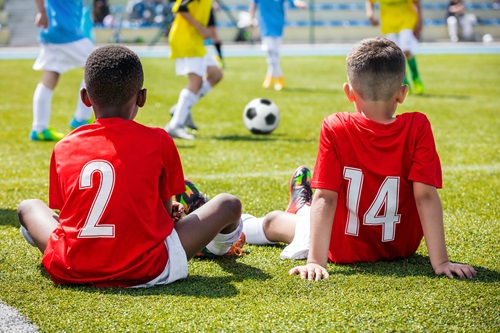
Photo © Susan Leggett | Dreamstime.com
Great news out of The Aspen Institute, whose National State of Play 2024 report found that youth athletes are returning to pre-COVID sports participation levels. A shadow over this trend, however, is that boys continue to play fewer sports and more children are being encouraged to specialize in one sport rather than engaging in multiple, even more so post-pandemic. There are also plenty of challenges facing low-income families who want their children to play organized sports.
Here are the salient points:
The Good News

Children are returning to pre-COVID sports participation rates. In 2023, core team sports participation (meaning playing on a regular basis) reached its highest levels for all ages of children since 2015, according to data from the Sports & Fitness Industry Association (SFIA).
More Older Children Playing
The bulk of the latest increase came from older youth – 594,000 more adolescents ages 13-17 regularly played sports in 2023 compared to 2022. Children ages 6-12 saw a minimal one-year increase of 58,000 more regular participants.
According to Tom Cove, SFIA senior advisor and former president/CEO, “Travel team sports that already had a paid coach or organization got right back to it after COVID. The difference between ages 6-12 and 13-17 is the older ones already had a system to come back to.”
Challenges for Athletes from Low-Income Families
The cost of travel at the team level made playing sports in 2023 most challenging for families of children ages 6-12 who come from the lowest-income homes (under $25,000). These children were the only income bracket that declined in core participation from the previous year (4% decrease); every other income bracket at that age increased between 3% and 6%.
The Mental Benefits of Sports
The value of a quality sports experience aligned with the needs and interests of youth can be immense. Adults who kept playing organized sports through their youth have fewer symptoms of anxiety and depression than those who never played or those who dropped out, according to a study by Ohio State. And those who dropped out of sports had poorer mental health than those who never played at all.
Fewer Boys Are Playing
As recently as 2013, half of boys ages 6-17 participated regularly in sports, according to SFIA data. Only 41% of boys did in 2023. While that’s a slight increase from a year earlier, this is an ongoing and troubling trend. Boys participation has resided at 41% or lower for eight straight years.
Girls ages 6-12 (34%) and 13-17 (38%) regularly played sports at higher levels in 2023 than in any recent year dating to at least 2012, according to SFIA. Older girls, in particular, are being added. Total team sports participation for girls 13-17 – meaning they played sports at least one day in the last year – climbed from 54% to 55% to 58% over the last three years after never being higher than 49% until 2021. The most recent NFHS Participation Study bears this out.

Racial Disparities in Youth Sports
Black children are playing sports less than they once did, while Hispanic participation is increasing. SFIA data shows that only 35% of Black youth ages 6-17 regularly participated in sports during 2023, down from 45% in 2013, when Black children played at a higher rate than White peers. White, Hispanic and Asian American children all played sports more frequently in 2023 than Black youth.
Youth Athletes Specializing in One Sport
Against the recommendations of pediatricians, sports medicine doctors and national governing bodies, more children are specializing in one sport – something likely driven by parents who want their children to get athletic scholarships or turn pro – despite the fact that this is extremely unlikely.
“We’ve got to get off this play more, pay more and the focus on every little element of development,” Cove said. “The purpose of youth sports is not to create the next Tiger Woods. It should be to provide a quality experience to the vast number of kids so they enjoy it, and part of that is winning, but not the main goal. We should be upfront about that. If we lose sight of that, we’re doing kids and families a disservice and we’re doing sport in general a disservice.”
More Talking Points:
- The LA84 Foundation survey found that two-thirds of parents (68%) say youth sports are becoming too specialized, and that they want better and more options for their children than local sport ecosystems are offering.
- Tackle football for ages 6-12 increased by 4% in 2023, while flag football was up 8%. Read about the growth of flag football at the high school level here.
- The latest SFIA data shows lacrosse and wrestling have the steepest participation declines for children ages 6-12 over the past one year, three years and five years (40% decline for both sports). The appearance of Lacrosse Sixes in the Olympics in Los Angeles in 2028, and the continued growth of wrestling at the high school level, including for girls, which has seen a massive increase, can only continue to boost both sports.
The full study can be downloaded without charge here.

